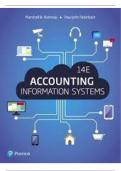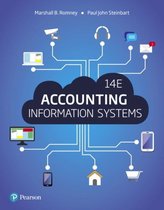,ACCOUNTING INFORMATION SYSTEMS 14TH EDITION GLOBAL
EDITION BY MARSHALL ROMNEY, PAUL STEINBART SOLUTIONS
MANUAL
CHAPTER 1
ACCOUNTING INFORMATION SYSTEMS: AN OVERVIEW
SUGGESTED ANSWERS TO DISCUSSION QUESTIONS
1.1 Discuss the concept of a system and the issues of goal conflict and goal congruence.
A system is a set of two or more components that are somehow interrelated and interact together to
achieve a specific goal. A system usually consists of smaller components called subsystems. These
subsystems have specific and defined functions, which interact with and support the larger system.
The concept of systems is key to information technology and AIS. All systems, including the AIS,
must work to achieve one or more organizational goals. Goal conflict results when a decision or
action of a subsystem is inconsistent with another subsystem or the system (organization) as a
whole. Goal congruence results when a subsystem achieves its goals while contributing to the
organization's overall goal. Subsystems should maximize organizational goals.
1.2 Give an example of how an AIS can improve decision making, and describe the multistep
activities involved in the process.
Decision making is a complex, multistep activity: identify the problem, collect and interpret
information, evaluate ways to solve the problem, select a solution methodology, and implement the
solution. An AIS can provide assistance in all phases of decision making. Reports can help to
identify potential problems. Decision models and analytical tools can be provided to users. Query
languages can gather relevant data to help make the decision. Various tools, such as graphical
interfaces, can help the decision maker interpret decision model results, evaluate them, and choose
among alternative courses of action. In addition, the AIS can provide feedback on the results of
actions.
An AIS can help improve decision making in several ways:
It can identify situations requiring management action. For example, a cost report with a large
variance might stimulate management to investigate and, if necessary, take corrective action.
It can reduce uncertainty and thereby provide a basis for choosing among alternative actions.
It can store information about the results of previous decisions, which provides valuable
feedback that can be used to improve future decisions. For example, if a company tries a
particular marketing strategy and the information gathered indicates that it did not succeed, the
company can use that information to select a different marketing strategy.
It can provide accurate information in a timely manner. For example, Walmart has an enormous
database that contains detailed information about sales transactions at each of its stores. It uses
this information to optimize the amount of each product carried at each store.
It can analyze sales data to discover items that are purchased together, and can use such
information to improve the layout of merchandise or to encourage additional sales of related
items. For example, Amazon uses its sales database to suggest additional books for customers
to purchase.
1-1
.
,Ch. 1: Accounting Information Systems: An Overview
1.3 You and a few of your classmates decided to become entrepreneurs. You came up with a great
idea for a new mobile phone application that you think will make lots of money. Your
business plan won second place in a local competition, and you are using the $10,000 prize to
support yourselves as you start your company.
a. Identify the key decisions you need to make to be successful entrepreneurs, the
information you need to make them, and the business processes you will need
to engage in.
b. Your company will need to exchange information with various external parties. Identify
the external parties, and specify the information received from and sent to each of them.
The author turns this question into an in-class group activity. Students are divided up in groups, told
to close their books, and given 15 minutes to:
a. Think through the business processes, key decisions, and information needs issues in their
group.
b. Identify the external users of information and specify the information received from and sent
to each of them.
One group is selected to present their answers to the class. The other groups are told to challenge
the group’s answers, provide alternative answers, and chip in with additional answers not provided
by the selected group. Since the group that presents is not selected until after the time has expired,
students are motivated to do a good job, as they will be presenting to their peers.
The value of this activity is not in arriving at a “right answer” as there are many right answers
and student answers will vary. Instead, it is in thinking through the issues presented in Table 1-2
(business processes, key decisions, and information needs) and Figure 1-1 (interactions with
external parties). Student answers should contain many of the things in Table 1-2 and Figure 1-1 as
well as others not shown, as a retail operation differs from an application development enterprise.
The author concludes the exercise by having the students turn to Table 1-2 and Figure 1-1 while
he emphasizes the need for owners, managers, and employees of organizations to identify the
information needed to make key decisions in the company’s business processes and the key
information interchanges with external parties. All of the data needed to produce this information
must be entered into the AIS, processed, stored, protected, and made available to the appropriate
users.
While this active learning activity takes more time than a lecture does, it drives the point home
much better than a lecture would. It also keeps the students more engaged in the material.
1-2
.
, Accounting Information Systems
1.4 How do an organization’s business processes and lines of business affect the design of its AIS?
Give several examples of how differences among organizations are reflected in their AIS.
An organization’s AIS must reflect its business processes and its line of business. For example:
Manufacturing companies will need a set of procedures and documents for the production
cycle; non-manufacturing companies do not.
Government agencies need procedures to track separately all inflows and outflows from various
funds, to ensure that legal requirements about the use of specific funds are followed. Financial
institutions do not need extensive inventory control systems.
Passenger service companies (e.g., airlines, bus, and trains) generally receive payments in
advance of providing services. Therefore, extensive billing and accounts receivable procedures
are not needed; instead, they must develop procedures to account for prepaid revenue.
Construction firms typically receive payments at regular intervals, based on the percentage of
work completed. Thus, their revenue cycles must be designed to track carefully all work
performed and the amount of work remaining to be done.
Service companies (e.g., public accounting and law firms) do not sell physical goods and,
therefore, do not need inventory control systems. They must develop and maintain detailed
records of the work performed for each customer to provide backup for the amounts billed.
Tracking individual employee time is especially important for these firms because labor is
the major cost component.
1.5 Figure 1-4 shows that organizational culture and the design of an AIS influence one another.
What does this imply about the degree to which an innovative system developed by one
company can be transferred to another company?
Since people are one of the basic components of any system, it will always be difficult to transfer
successfully a specific information systems design intact to another organization. Considering in
advance how aspects of the new organizational culture are likely to affect acceptance of the system
can increase the chances for successful transfer. Doing so may enable the organization to take steps
to mitigate likely causes of resistance. The design of an AIS, however, itself can influence and
change an organization’s culture and philosophy. Therefore, with adequate top management
support, implementation of a new AIS can be used as a vehicle to change an organization. The
reciprocal effects of technology and organizational culture on one another, however, mean that it is
unrealistic to expect that the introduction of a new AIS will produce the same results observed in
another organization.
1-3
.





